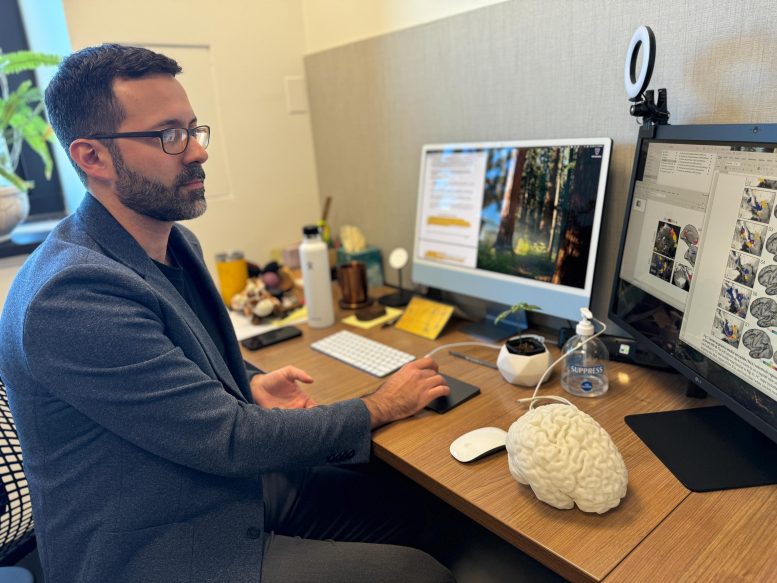New research by Northwestern Medicine reveals how humans have evolved advanced brain regions to interpret others' thoughts, connecting these areas with the amygdala, a part of the brain involved in emotional processing.
- Study sought to better understand how humans evolved to become skilled at thinking about others.
- Newer parts of the brain that support social interactions are connected to and in constant communication with the ancient amygdala.
- First study to map with fMRI never-before-seen details of the brain's social cognitive network.
- Findings have implications for one day treating psychiatric conditions such as anxiety and depression.
Advanced Brain Imaging Reveals Keys to Social Interaction
We've all experienced it: leaving a party only to be swamped by intrusive thoughts about what others might have been thinking. "Did I talk too much?" "Was my joke offensive?" "Did they enjoy themselves?"
A new study by Northwestern Medicine explores how humans evolved to excel at understanding the thoughts and feelings of others. These insights could eventually lead to new approaches for treating psychiatric conditions like anxiety and depression.
"We spend a lot of time wondering, 'What is that person feeling, thinking? Did I say something to upset them?'" said senior author Rodrigo Braga. "The parts of the brain that allow us to do this are in regions of the human brain that have expanded recently in our evolution, and that implies that it's a recently developed process. In essence, you're putting yourself in someone else's mind and making inferences about what that person is thinking when you cannot really know."

Evolution of Social Cognition
The study found the more recently evolved and advanced parts of the human brain that support social interactions — called the social cognitive network — are connected to and in constant communication with an ancient part of the brain called the amygdala.
Often referred to as our "lizard brain," the amygdala typically is associated with detecting threats and processing fear. A classic example of the amygdala in action is someone's physiological and emotional response to seeing a snake: startled body, racing heart, sweaty palms. But the amygdala also does other things, Braga said.
"For instance, the amygdala is responsible for social behaviors like parenting, mating, aggression and the navigation of social-dominance hierarchies," said Braga, an assistant professor of neurology at Northwestern University Feinberg School of Medicine. "Previous studies have found co-activation of the amygdala and social cognitive network, but our study is novel because it shows the communication is always happening."
The study was published on November 22 in the journal Science Advances.
Advanced Imaging Techniques Reveal Insights
Within the amygdala, there's a specific part called the medial nucleus that is very important for social behaviors. This study was the first to show the amygdala's medial nucleus is connected to newly evolved social cognitive network regions, which are involved in thinking about other people. This link to the amygdala helps shape the function of the social cognitive network by giving it access to the amygdala's role in processing emotionally important content.
This was only possible because of functional magnetic resonance imaging (fMRI), a noninvasive brain-imaging technique that measures brain activity by detecting changes in blood oxygen levels. A collaborator at the University of Minnesota and co-author on the study, Kendrick Kay, provided Braga and co-corresponding author Donnisa Edmonds with fMRI data from six study participants' brains, as part of the Natural Scenes Dataset (NSD).

These high-resolution scans enabled the scientists to see details of the social cognitive network that had never been detected on lower-resolution brain scans. What's more, they were able to replicate the findings up to two times in each individual.
"One of the most exciting things is we were able to identify network regions we weren't able to see before," said Edmonds, a neuroscience Ph.D. candidate in Braga's lab at Northwestern. "That's something that had been underappreciated before our study, and we were able to get at that because we had such high-resolution data."

Potential Treatment of Anxiety and Depression
Both anxiety and depression involve amygdala hyperactivity, which can contribute to excessive emotional responses and impaired emotional regulation, Edmonds said. Currently, someone with either condition could receive deep brain stimulation for treatment, but since the amygdala is located deep within the brain, directly behind the eyes, it means having an invasive, surgical procedure. Now, with this study's findings, a much less-invasive procedure, transcranial magnetic stimulation (TMS), might be able to use knowledge about this brain connection to improve treatment, the authors said.
"Through this knowledge that the amygdala is connected to other brain regions — potentially some that are closer to the skull, which is an easier region to target — that means people who do TMS could target the amygdala instead by targeting these other regions," Edmonds said.
Reference: "The human social cognitive network contains multiple regions within the amygdala" by Donnisa Edmonds, Joseph J. Salvo, Nathan Anderson, Maya Lakshman, Qiaohan Yang, Kendrick Kay, Christina Zelano and Rodrigo M. Braga, 22 November 2024, Science Advances.
DOI: 10.1126/sciadv.adp0453
Other Northwestern co-authors include Christina Zelano, Joseph J. Salvo, Nathan Anderson, Maya Lakshman and Qiaohan Yang.
News
Scientists Melt Cancer’s Hidden “Power Hubs” and Stop Tumor Growth
Researchers discovered that in a rare kidney cancer, RNA builds droplet-like hubs that act as growth control centers inside tumor cells. By engineering a molecular switch to dissolve these hubs, they were able to halt cancer [...]
Platelet-inspired nanoparticles could improve treatment of inflammatory diseases
Scientists have developed platelet-inspired nanoparticles that deliver anti-inflammatory drugs directly to brain-computer interface implants, doubling their effectiveness. Scientists have found a way to improve the performance of brain-computer interface (BCI) electrodes by delivering anti-inflammatory drugs directly [...]
After 150 years, a new chapter in cancer therapy is finally beginning
For decades, researchers have been looking for ways to destroy cancer cells in a targeted manner without further weakening the body. But for many patients whose immune system is severely impaired by chemotherapy or radiation, [...]
Older chemical libraries show promise for fighting resistant strains of COVID-19 virus
SARS‑CoV‑2, the virus that causes COVID-19, continues to mutate, with some newer strains becoming less responsive to current antiviral treatments like Paxlovid. Now, University of California San Diego scientists and an international team of [...]
Lower doses of immunotherapy for skin cancer give better results, study suggests
According to a new study, lower doses of approved immunotherapy for malignant melanoma can give better results against tumors, while reducing side effects. This is reported by researchers at Karolinska Institutet in the Journal of the National [...]
Researchers highlight five pathways through which microplastics can harm the brain
Microplastics could be fueling neurodegenerative diseases like Alzheimer's and Parkinson's, with a new study highlighting five ways microplastics can trigger inflammation and damage in the brain. More than 57 million people live with dementia, [...]
Tiny Metal Nanodots Obliterate Cancer Cells While Largely Sparing Healthy Tissue
Scientists have developed tiny metal-oxide particles that push cancer cells past their stress limits while sparing healthy tissue. An international team led by RMIT University has developed tiny particles called nanodots, crafted from a metallic compound, [...]
Gold Nanoclusters Could Supercharge Quantum Computers
Researchers found that gold “super atoms” can behave like the atoms in top-tier quantum systems—only far easier to scale. These tiny clusters can be customized at the molecular level, offering a powerful, tunable foundation [...]
A single shot of HPV vaccine may be enough to fight cervical cancer, study finds
WASHINGTON -- A single HPV vaccination appears just as effective as two doses at preventing the viral infection that causes cervical cancer, researchers reported Wednesday. HPV, or human papillomavirus, is very common and spread [...]
New technique overcomes technological barrier in 3D brain imaging
Scientists at the Swiss Light Source SLS have succeeded in mapping a piece of brain tissue in 3D at unprecedented resolution using X-rays, non-destructively. The breakthrough overcomes a long-standing technological barrier that had limited [...]
Scientists Uncover Hidden Blood Pattern in Long COVID
Researchers found persistent microclot and NET structures in Long COVID blood that may explain long-lasting symptoms. Researchers examining Long COVID have identified a structural connection between circulating microclots and neutrophil extracellular traps (NETs). The [...]
This Cellular Trick Helps Cancer Spread, but Could Also Stop It
Groups of normal cbiells can sense far into their surroundings, helping explain cancer cell migration. Understanding this ability could lead to new ways to limit tumor spread. The tale of the princess and the [...]
New mRNA therapy targets drug-resistant pneumonia
Bacteria that multiply on surfaces are a major headache in health care when they gain a foothold on, for example, implants or in catheters. Researchers at Chalmers University of Technology in Sweden have found [...]
Current Heart Health Guidelines Are Failing To Catch a Deadly Genetic Killer
New research reveals that standard screening misses most people with a common inherited cholesterol disorder. A Mayo Clinic study reports that current genetic screening guidelines overlook most people who have familial hypercholesterolemia, an inherited disorder that [...]
Scientists Identify the Evolutionary “Purpose” of Consciousness
Summary: Researchers at Ruhr University Bochum explore why consciousness evolved and why different species developed it in distinct ways. By comparing humans with birds, they show that complex awareness may arise through different neural architectures yet [...]
Novel mRNA therapy curbs antibiotic-resistant infections in preclinical lung models
Researchers at the Icahn School of Medicine at Mount Sinai and collaborators have reported early success with a novel mRNA-based therapy designed to combat antibiotic-resistant bacteria. The findings, published in Nature Biotechnology, show that in [...]





















